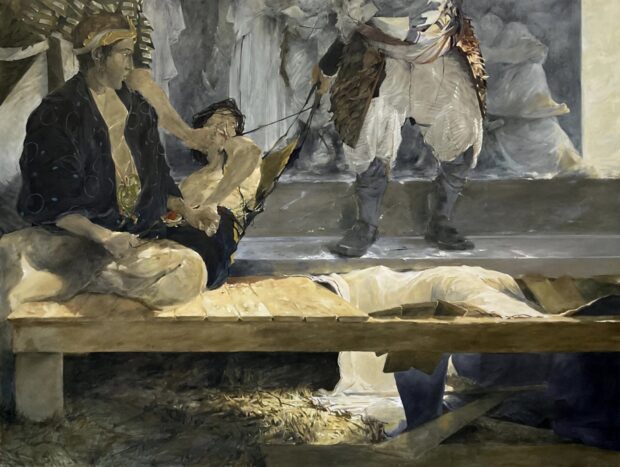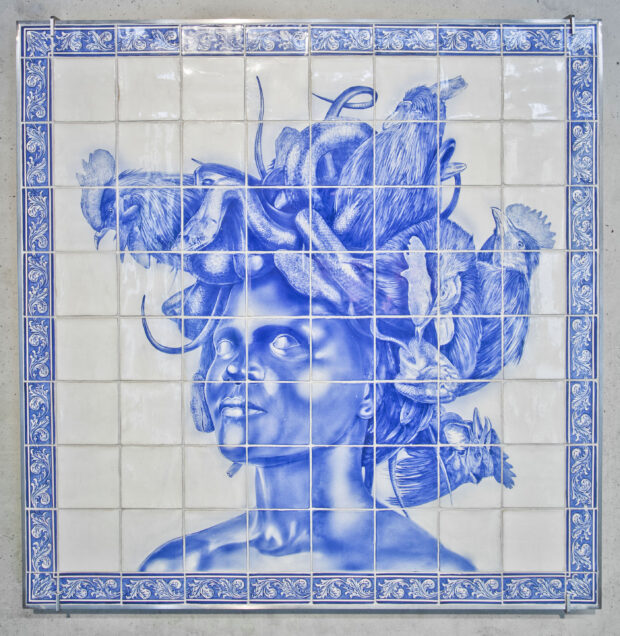What is known as “Armory Week” took place early March in New York. The roughly seven-day-long art extravaganza takes its name from the 1913 Armory Show—America’s first large-scale exhibition of modern art, which took place in the Regiment Armory on Lexington Avenue. Every year, Armory Week encompasses numerous art fairs and events across the city, providing excellent opportunities to not only look at art and meet artists and art world professionals, but also to practice observing the art market and predicting forms it could take in the foreseeable future. On March 6, I attended the Art on Paper Fair. As many will likely admit, time at art shows goes by quickly and is never quite enough. Thus, I focused my visit on new, alternative uses of the paper medium, observing the gamut displayed, speaking with artists and dealers, and gauging the visitors’ reactions.

One thing that became noticeable early on, while walking around the space, was the number of conversations concerning the apparent two-dimensionality of most works exhibited at the fair. Such observations were offered with a tone of disappointment, as though the future of paper, as presented here, had circled back on itself and was, once again, non-sculptural and flat. Despite the public’s generalizations about the prevalence of age-old applications of pencil, ink and paint, this year’s fair was actually marked with works that pushed far beyond tradition.
There were numerous instances of artworks that toyed with both two and three-dimensionality. A fascinating example was found in the offerings of Canadian artist and author Cybèle Young, represented by Forum Gallery, whose works are sculptures trapped in a frame. Elsewhere, Browngrotta gallery exhibited only non-flat works. Of particular note was “Vanishing and Emerging Wall,” 2009, a round textile by Japanese artist Hideho Tanaka woven out of squares of paper, painted with stripes and hung in such a way as to create vertical folds. Similarly, Owen James Gallery exhibited small paper pulp sculptures by Adam Frezza and Terri Chiao. The sculptures’ whimsical colors, glitter, and coral-like structure created a playful atmosphere that made them alluring to fair-visitors of all ages. Overall, encountering works that experimented with unique applications of the paper medium made the whole visit far more lively than one could typically expect of these fairs—like a treasure hunt of art on paper.

The largest sculptural piece of the entire fair was in fact the first work that the visitor confronted upon entering fair grounds. The large, elaborate floor sculpture was created by Chinese artist Li Hongbo—one of several artists represented by Klein Sun Gallery, whose work demonstrates an intriguing mixture of flat and sculptural approaches. Another one of the gallery’s most popular works was a paper bust of a classical male head, again, by Li Hongbo that distended and twisted like a slinky—the popular ‘90s toy. The sculpture posed an intriguing dialogue between eastern and western artistic concepts, such as the contrast of impermeable European marble and superfine Japanese papers, or the difference between precise Renaissance proportions and the more elastic idea of space evidenced in traditional Chinese painting. The gallery’s founder, Eli Klein, has made a career of backing groundbreaking Chinese artists. This made me wonder: was the prevailing interplay between two and three dimensions at Klein Sun simply a sage marketing strategy or, perhaps more enticingly, a glimpse into the future of contemporary Asian art?

Indeed, throughout the fair, Asian art continued to impress: Gallery Jin, based in Tokyo, displayed works that ranged from origami and paper sculpture to drawings and prints. Their works made of ink on paper were understandably admired. Historically, Japanese art has been associated with magnificent ink drawings. Gallery Jin’s selections, however, presented a glimpse into alternative approaches. In the corner of the booth hung small-scale works by Asako Setoh: diminuitive sheets of slightly textured paper illustrated with meticulous geometric and organic lines that resembled a type of imaginary writing. Speaking with Setoh at the fair, I pointed out the strong sense of meditation the works inspired; she noted that this was in fact an important part of her process. Time was another factor that played into the creation of these works, some of which took months to complete. Setoh’s process therefore defies a superficial understanding of paper as ephemeral, recalling instead the time-intensive practices of journaling or mapping.

As a small group gathered around the artist one visitor suggested that her works could successfully be applied to fabric. While this seemed to me the polar opposite of her current approach—marked by painstakingly detailed and labor-intensive handwork—it was interesting to note a different perspective expressed by a buyer. This brought up the question of why drawings like Setoh’s are still confused with craft. It could be telling for the viewer who may lack an understanding of the time-intensive drawing process. Perhaps drawings like these could even be misunderstoodas craftsbecausepatterns areso intensely associated with commercial graphic design. Or, possibly most alarmingly,it evensuggests that the art markethas rendered the buyer more accustomed to considering works like Setoh’s as simply commercial and marketable objects—ones which require less sophisticatedintrospectionthan for example, paintings or sculptures.

Generally, a predominant number of works shown at this year’s Art on Paper Fair were produced by artists with interdisciplinary backgrounds, or whose visual results evoked references to other practices. In particular, architectural references resonated throughout. There were realistic collages replicating ruins and textures of structural material, and others that created a sense of a distorted perspective space. For example, the set of sculptures by Tim Gratkowski, on view at the Walter Maciel Gallery booth, harken back to the artist’s background as an architect. His concrete and paper constructions consist of short orthogonal concrete volumes out of which explode colorful blasts of paper. Crumpled pages appear to break out of the solid concrete blocks as if the more forceful material of the two. Through these dichotomous elements, where the concrete succumbs to the exploding blasts of paper, in fact, the artist plays with the idea of strength, a welcome sight in an event devoted to a traditionally delicate medium.

Overall, Art on Paper 2016 was a rich and informative event that left me questioning how much further paper can go. What some experts and visitors seem to view as an outdated medium appeared, on this occasion, to be on a constructive path to overcoming its perceived limitations and pushing towards new, innovative directions. Though not universally embraced by visitors, many of the represented artists at the fair exhibited a number of innovative reimaginations of paper as a two and three dimensional practice, promising an expanded—and exciting—market for the medium in the future.








[…] Among other matters, paper’s relevance as a medium, and pushing beyond the basic understanding of what is the paper medium are discussed in this article. It is, overall, a thorough review of the Art on Paper Fair that took place earlier in 2016 in New York for IFA Contemporary. The entire piece is available for reading here. […]